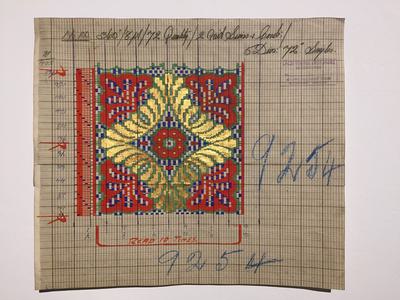The Quarry Steen, The Kemnay Steens
By
James Winnett
2020
- Sculpture
- Urban Dynamics & Public Realm
- Participatory & Collaborative
- Granite
- Stone
- Quarry
- Sculpture
- Aberdeenshire
- Scotland
- Folklore
- Commission
Dimensions
100 x 100 x 75
This two-tonne block of granite sits alongside a footpath in Dalmadilly adjacent to the junction with Aquithie Road. It was quarried just 200m away at Kemnay Quarry and a line of drill holes from the quarrying process are still visible on one side. The design has been sandblasted into the granite with a black infill then added. The granite itself would have been formed over 400 million years ago and is close-grained and extremely hard.
The granite industry in Kemnay was revolutionised by the arrival of John Fyfe in 1858, which led to massive changes in the village. Although granite had been quarried in Kemnay on a small scale, it was only with the arrival of the railway that the industry really flourished. In 1858, while the railway was being built, John Fyfe took a lease of the Paradise Hill quarry. It was ideally placed with the railway once running exactly where this stone stands today.
The design on the stone shows a steam derrick for moving blocks of stone at the quarry floor. This major technical advancement was developed through John Fyfe's conversations with Andrew Barclay, a young engineer in Kilmarnock. The Scottish steam derrick allowed Fyfe to quarry downwards for better stone rather than just into the hill – a development that revolutionised quarrying worldwide. The main quarry would eventually reach a depth of 122m.
A few years later John Fyfe saw a postman pass a bag of mail across the Dee at Abergeldie by means of an endless rope. This gave him the idea for the steam powered 'Blondin' – a travelling carriage suspended from an endless cable that could be lowered to retrieve stone from the quarry floor. Stones could then be transferred directly into the mason's shed (shown on the right of the stone) through special roof openings. Named after Charles Blondin, a French tightrope walker, Fyfe’s invention became standard equipment in quarries internationally, with Kemnay's Blondin able to lift blocks weighing 100 tonnes.
An artificial raised platform was built to house one of the steel lattice towers for the Blondin. This became known as ‘Spion Kop‘ after a hill of the same name in a battle of the Boer War. The design on the stone also shows a crane at the pit edge from where quarrymen would be lowered in hutches and two huts known as 'scathies' where road setts or 'cassies' were made.
The walls of the quarry list a small selection of the various projects where Kemnay granite has been used.
The stone is one of the Kemnay Steens, nine carved stones placed along footpaths in and around the village with the aim of encouraging people to explore the rich history, folklore and natural identity of the surrounding landscape.
The stones reference local Pictish carvings and later medieval styles but they also have their own visual vocabulary; the more stones that are encountered, the more reoccurring symbols, characters and themes are noticed. Each stone tells its own story but there is also a deeper narrative hidden in the carvings, waiting to be unpicked.
The designs for the artworks are the result of six months of research and engagement activity which included community events, talks and stone carving workshops.
The project began in July 2019 and was led by The Kemnay Public Art Group a sub-group of Greener Kemnay; a group of local residents who support the reduction of the carbon footprint of the village. The group was asked by Aberdeenshire Council to manage a public art project using the balance remaining in the Percent for Art Fund, accumulated from previous housing developments. Additional funding was then secured from The National Lottery Community Fund.
Helping Artists Keep Going
Axis is an artist-led charity supporting contemporary visual artists with resources, connection, and visibility.







